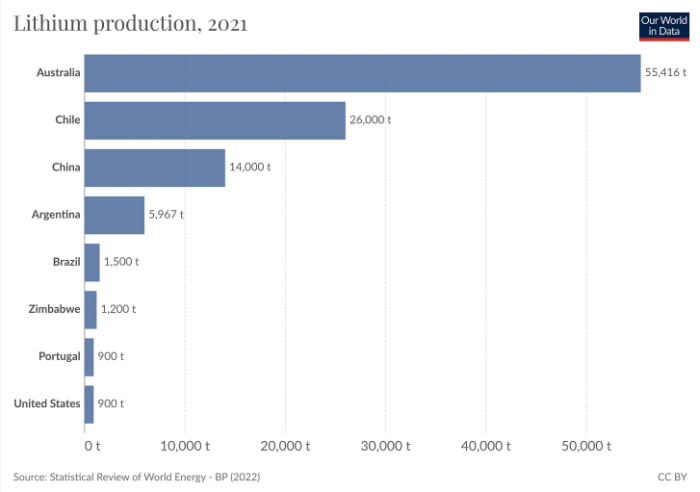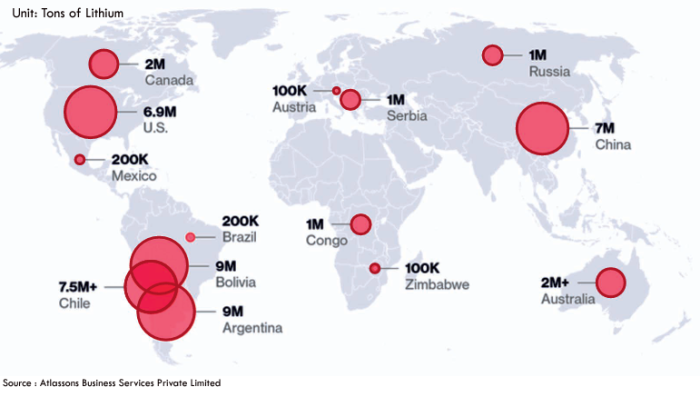Critical elements, often referred to as critical minerals or critical raw materials, are elements that are essential for modern industry and technology but have supply risks associated with them. These risks might be due to geographic concentration of production, the political stability of producing countries, the economic viability of extraction, regulatory factors, and other market dynamics. The criticality of these elements can also be heightened by their importance in applications that are crucial for national security, economic well-being, or environmental sustainability. The examples of critical elements are shown in the table below:
| Critical elements | Applications |
|---|---|
| Cobalt | Crucial for battery technology, particularly in electric vehicles and smartphones |
| Lithium | Essential for lithium-ion batteries used in electric vehicles and portable electronics |
| Gallium | Important for semiconductors and photovoltaic applications |
| Graphite | Used in battery anodes and also in nuclear reactors |
| Indium | Important for touch screens, LCDs, and thin-film solar cells |
| Tantalum | Used in electronic components, mainly capacitors and high-power resistors |
| Titanium | Critical for aerospace applications due to its strength-to-weight ration and corrosion resistance. |
| Platinum Group Metals (PGMs): include platinum, palladium, and rhodium | Critical for catalytic converters in automobiles and various electronics and chemical applications |
| Rare Earth Elements (REEs): 17 elements, for example, neodymium and yttrium | Used for high-strength magnets used in wind turbines, electric vehicles, and various defense applications |
| Vanadium | Vanadium redox flow batteries (VRFBs) used for medium- to long-duration energy storage, such as microgrids, electric vehicles, photovoltaic power stations |
There are a few issues about the critical minerals:
- Economic importance: Many critical elements are essential for technologies that drive economic growth, particularly in sectors like renewable energy, electronics, and defense.
- Supply Risk: Many of these elements are produced in a limited number of countries. For instance, China dominates the supply of rare earth elements, which raises concerns about supply security for other nations.
- Environmental and Regulatory Issues: The mining and processing of critical elements can be environmentally damaging, leading to strict and costly regulatory frameworks which can impact supply.
- Recycling Challenges: Some critical elements are difficult to recycle from end-of-life products, further complicating the supply scenario.
Let’s consider lithium (Li) as an example. Lithium deposits are typically found in various types of rock formations. The most common rock types associated with Li deposits include:
- Pegmatites: These are intrusive igneous rocks formed from the crystallization of magma beneath the Earth's surface. Lithium-rich pegmatites are perhaps the most significant source of lithium. Spodumene and petalite, two lithium-bearing minerals, are commonly extracted from pegmatite formations.
- Brines: Lithium is also extracted from brine pools and salt flats, where it is concentrated over time through the evaporation of water. These brines are typically found in lake beds within basins, where lithium has been leached from volcanic rocks and concentrated by arid climatic conditions. The lithium-rich brine is pumped from the ground and processed to extract lithium salts. Famous examples include the Salar de Atacama in Chile and the Clayton Valley in Nevada, USA.
- Sedimentary Clays: Certain clay deposits, specifically hectorite clays, can also contain significant amounts of lithium. These clays can be processed to extract lithium, although this is less common than extraction from pegmatites and brines. Deposits of this type are found in regions like the Jadar Valley in Serbia.
- Geothermal Brines: Lithium can also be extracted from the brines associated with geothermal power facilities. As hot geothermal fluids are pumped from the Earth, they can carry dissolved lithium, which can be extracted at the surface.
These geological settings are critical for lithium exploration and exploitation, especially given the growing demand for lithium in the production of batteries and other technologies.
Lithium deposits are found in various locations around the world, with significant concentrations in specific regions due to the geological conditions favorable for their formation.

| Country | Tons |
|---|---|
| Australia | 55,416 |
| Chile | 26,000 |
| China | 14,000 |
| Argentina | 5,967 |
| Brazil | 1,500 |
| Zimbabwe | 1,200 |
| Portugal | 900 |
| United States | 900 |
Here are some key areas:
- Australia: Australia is a leading producer of lithium, primarily mined from hard rock sources, specifically spodumene. The Greenbushes lithium mine in Western Australia is one of the world's largest and highest grade lithium mines.
- South America: The "Lithium Triangle" is perhaps the most famous and significant source of lithium from brine deposits. It spans parts of Argentina, Bolivia, and Chile. This region includes the Salar de Atacama in Chile, Salar del Hombre Muerto in Argentina, and Salar de Uyuni in Bolivia. These salt flats are some of the richest lithium sources globally.
- China: China has significant lithium deposits, both in the form of hard rock mining (predominantly from spodumene) in regions like Sichuan, as well as from brine sources in Qinghai province.
- Africa: Zimbabwe has several lithium-rich pegmatite deposits, and there are developments in other countries like Namibia and Ghana focusing on pegmatites.
- Europe: Serbia hosts one of Europe’s largest lithium deposits at the Jadar Valley, where lithium is found in jadarite, a unique lithium-bearing mineral.
- North America: The United States has lithium deposits in Nevada, with the Silver Peak lithium mine in Clayton Valley being the most significant. This mine extracts lithium from brines. Additionally, there are potential lithium resources in North Carolina associated with pegmatites, and new developments are ongoing in regions like Thacker Pass, Nevada.

| Country | Tons |
|---|---|
| Canada | 2 million |
| U.S. | 6.9 million |
| Mexico | 200 thousand |
| Brazil | 200 thousand |
| Bolivia | 9 million |
| Chile | 7.5+ million |
| Argentina | 9 million |
| Austria | 100 thousand |
| Serbia | 1 million |
| Congo | 1 million |
| Zimbabwe | 100 thousand |
| Russia | 1 million |
| China | 7 million |
| Australia | 2+ million |
Not all of these deposits are feasible to extract with our current technologies, or they may be too expensive to do so. The amount of lithium that we know we can technologically and economically mine is called ‘reserves.’
According to the USG’s Lithium Statistics and Information Report , in 2021, it was estimated that the world had 88 million tons of lithium. These are referred to as "resources." Of this total, 22 million tons were considered feasible to extract, and these are classified as "reserves." What’s important about these figures is that they change over time. We continually discover new lithium deposits, and as our technologies advance and market conditions improve, more of our resources become economical to extract.
However, in addition to economic feasibility, environmental concerns are at the top of the priorities. As an example, despite a recent discovery of a $1.5 billion lithium deposit in western Maine, the mining of it could be hard because of the potential heavy metal contamination of surrounding waters and soil and strong public opposition.
